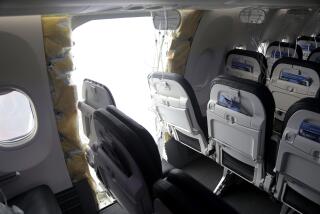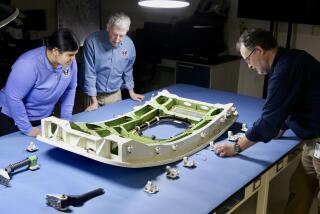Search for Malaysia jet shifts 680 miles northeast
BEIJING — The Australian Maritime Safety Authority said Friday it had a new “credible lead” that suggested Malaysia Airlines Flight 370 probably crashed 680 miles northeast of the search area where more than a dozen planes and ships have been looking the last 10 days.
The location was changed after a new analysis of radar data from the South China Sea and Malacca Strait before contact was lost with the Boeing 777, which was carrying 239 passengers and crew members when it disappeared March 8.
“It indicated that the aircraft was traveling faster than previously estimated, resulting in increased fuel usage and reducing the possible distance the aircraft traveled south into the Indian Ocean,” the Australian agency said Friday.
The new area is 123,000 square miles and about 1,250 miles west of Perth, Australia, about 300 miles closer to land, which would allow planes to spend more time over water searching. Weather conditions and currents are also less rugged.
“I’m not sure we will get perfect weather, but it is likely to be better than it was in the past,” said John Young, an agency official, at a news conference Friday morning in Canberra. He rejected accusations that the international search team had been wasting its time.
“This is the normal business of search and rescue. ... Refined analysis takes you to a different place. I don’t call the original work a waste of time,” Young said.
The shift means that widely published satellite imagery of floating objects released in recent days by Australia, Thailand and Japan probably had no relationship to the missing flight and were just more red herrings in the search effort.
“This will remain a somewhat inexact science,” said Martin Dolan, chief commissioner of the Australian Transport Safety Bureau.
Flight 370 disappeared en route from Kuala Lumpur to Beijing. Investigators now believe the flight made virtually a 180-degree turn shortly after takeoff, heading southwest into the Indian Ocean.
Australian Prime Minister Tony Abbott on Friday reportedly called the effort “an extraordinarily difficult search, and an agonizing wait for family and friends of the passengers and crew.”
“We owe it to them to follow every credible lead and to keep the public informed of significant new developments,” he said. “That is what we are doing.”
The Australian Maritime Safety Authority said Friday that 10 aircraft and five ships would join the search.
The U.S. Navy said it was sending a second P-8 Poseidon that was to fly Friday from Okinawa, Japan, to Perth, and would replace an older P-3 Orion. Officials call the P-8 “the most advanced long-range anti-submarine and anti-surface warfare aircraft in the world.” Other aircraft were provided by other nations.
Search flights were grounded most of Thursday — the second such delay this week — because of gale-force winds and swelling seas.
Although the Malaysian government last weekend declared the flight lost without survivors, many families say they are unwilling to give up hope until confirmed debris is found.
Chinese insurance companies, however, have begun to pay compensation on life insurance policies for passengers who were on board the flight.
China Life, the country’s largest life insurance company, said Thursday it had already paid $680,000 to families of seven passengers. “China Life is deeply grieved at the news and will ensure compensation and all other related services are fully implemented,” a company spokesman was quoted as telling the official New China News Agency.
Two other Chinese insurance companies said they were also paying claims on the assumption that all passengers on the flight had been killed.
Times staff writer W.J. Hennigan in Los Angeles contributed to this report.
More to Read
Start your day right
Sign up for Essential California for news, features and recommendations from the L.A. Times and beyond in your inbox six days a week.
You may occasionally receive promotional content from the Los Angeles Times.





